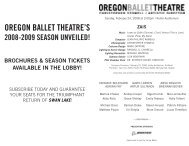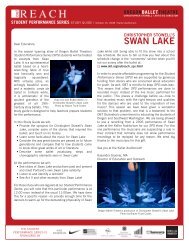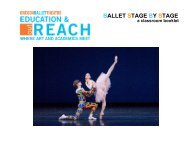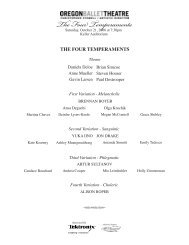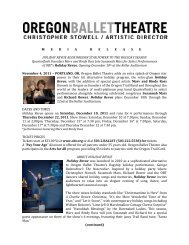Left Unsaid - Oregon Ballet Theatre
Left Unsaid - Oregon Ballet Theatre
Left Unsaid - Oregon Ballet Theatre
You also want an ePaper? Increase the reach of your titles
YUMPU automatically turns print PDFs into web optimized ePapers that Google loves.
Student Performance SerieS STudy Guide / april 23 & 24, 2009 / newmark <strong>Theatre</strong><br />
dear educators,<br />
We look forward to seeing you at <strong>Left</strong> <strong>Unsaid</strong>, the next<br />
of oregon ballet <strong>Theatre</strong>’s Student Performance Series<br />
to be held at the newmark <strong>Theatre</strong> at 11:00 on april<br />
23rd and 24th. The following Study Guide is designed to<br />
provide information for you to explore with your students.<br />
it includes information about the three works that will be<br />
seen at the show. The first piece will be Tarantella, followed<br />
by <strong>Left</strong> <strong>Unsaid</strong>, and the final piece will be Il Distratto.<br />
The Study Guide includes information about each of<br />
the ballets, each composer and each choreographer.<br />
interspersed throughout the Study Guide you will see<br />
sections entitled “Think about it...” and “Dance about it...”<br />
These sections offer a series of questions for students to<br />
broaden their thinking, or movement activities that allow<br />
students to physically explore elements that will be seen<br />
at the performance. Since the Study Guide is designed<br />
for a broad range of students, teachers are encouraged to<br />
use the guide as a starting point and are encouraged to<br />
play with the suggestions. if you find that you have had<br />
a particularly interesting teaching moment as a result of<br />
the ideas here, please send me a note. i am developing a<br />
way for teachers to share ideas about including dance in<br />
schools.<br />
Please check the Student Performance Series page at<br />
obT’s website (www.obt.org) for important downloads for<br />
SPS attendees.<br />
TARANTELLA<br />
obT will open the Student Performance Series at the<br />
newmark <strong>Theatre</strong> with a short ballet called Tarantella. The<br />
ballet was choreographed by George balanchine to music<br />
entitled Grand Tarantelle for Piano and Orchestra, Op. 67<br />
(ca. 1866) by Louis moreau Gottschalk. The music was<br />
reconstructed and orchestrated for new york city ballet<br />
by hershy Kay.<br />
Tarantella is an effervescent dance for two people—a pas<br />
de deux. it is a virtuosic showcase of nimbly danced steps<br />
by a man and woman including a profusion of jumps, spins,<br />
and quick changes of direction. They both joyfully share the<br />
striking of a tambourine and are dressed in costumes that<br />
make one think of traditional italian festivals. although<br />
The STudenT<br />
Performance SerieS iS<br />
SPonSored by<br />
KuSe<br />
foundaTion<br />
Kathi martuza and adrian fry in nicolo fonte’s <strong>Left</strong> <strong>Unsaid</strong><br />
Photo by andy batt<br />
on behalf of all of oregon ballet <strong>Theatre</strong> i thank you for<br />
bringing your students to the theater and for taking time to<br />
enhance their experience by talking about the performance<br />
before and after the show.<br />
See you at the newmark,<br />
Kasandra Gruener, ma<br />
director of education and outreach<br />
ConTenTs:<br />
•Tarantella - overview, composer, choreographer<br />
•<strong>Left</strong> <strong>Unsaid</strong> - overview, composer, choreographer<br />
•Il Distratto - overview, composer, choreographer<br />
brief, this explosive pas de deux typifies the ways in which<br />
George balanchine expanded the traditional vocabulary<br />
of classical ballet. a classical pas de deux has a certain<br />
form—first the dancers do a slower dance together, then<br />
they both have solos that showcase their specific talents,<br />
culminating in a dance together that seems almost<br />
competitive in its difficulty. balanchine infuses this pas de<br />
deux with fast paced movements at all times and includes<br />
folk dance steps, such as the man moving forward in a<br />
difficult knee walking step while striking his tambourine<br />
at the foot of the ballerina who is traveling forward doing<br />
a challenging series of turns. many audiences applaud at<br />
the sight of this part of the dance—you can too!
Student Performance SerieS STudy Guide / april 23 & 24, 2009 / newmark <strong>Theatre</strong><br />
CoMPoser: Louis Moreau goTTsChaLk (1829 – 1869)<br />
Though Louis moreau<br />
Gottshalk is considered<br />
among the first american<br />
composers to attain a high<br />
standard in the world of<br />
classical music, he spent<br />
much of his short life<br />
studying and performing<br />
outside the united States.<br />
Gottschalk was born to a<br />
Jewish businessman from<br />
London and a white haitian<br />
creole in new orleans, and<br />
was partly raised by his<br />
Grandmother buslé and his<br />
nurse Sally, who had both<br />
been born in Saint-domingue<br />
(later known as haiti). With<br />
this background, as a child<br />
he was exposed to a wide<br />
variety of musical traditions.<br />
Gottschalk was recognized<br />
Louis moreau Gottshalk<br />
as a wunderkind by the new orleans bourgeois establishment<br />
when, in 1840, he gave his informal public debut as a pianist at<br />
the new St. charles hotel.<br />
at the age of 13, he sailed to europe for classical training<br />
in music. in a letter to his mother he wrote, “i definitely expect<br />
that in two years or perhaps less i shall be earning a living on<br />
my own.” The Paris conservatoire, however, initially rejected<br />
his application on the grounds of his nationality. his examiner<br />
commented that “america is a country of steam engines.” in<br />
the years to follow, despite the initial rejection by the musical<br />
establishment, he built a career as a piano virtuoso, prompting<br />
frédéric chopin to predict that Gottschalk would become one of<br />
the foremost pianists of the century.<br />
back home, he established himself as a major figure in<br />
american musical life, partly as a result of tremendous hard<br />
work, as is evident from his travel schedule which, at one point<br />
Think abouT iT...<br />
Wunderkind is a German word that translates to “wonder<br />
child.” it describes someone who is successful or shows great<br />
talent at a young age. do you know of any wunderkind?<br />
What was The Paris conservatoire examiner trying to say about<br />
america and Gottschalk’s potential to be a great artist when he<br />
said, “america is a country of steam engines.”<br />
Why would Gottschalk write a diary? how does it help us now<br />
to know about his experience and his time? do you keep a<br />
diary?<br />
in 1862, included 85 concerts (all at different locations) in just<br />
four and a half months. in his diary he wrote, “arrived half past<br />
eight at the hotel, took in a hurry a cup of bad tea, and away to<br />
business. one herring for dinner! nine hours on the train! and, in<br />
spite of everything, five hundred persons who have paid that you<br />
may give them two hours of poesy, of passion, and of inspiration.<br />
i confess to you secretly that they certainly will be cheated this<br />
evening.”<br />
Gottschalk lived and performed in cuba, South america<br />
and the caribbean for extended periods of time—his concerts<br />
were tremendously successful all across South america and<br />
sometimes took the form of “monster concerts” involving up<br />
to 650 performers—and he happily incorporated their musical<br />
influences and traditions into his compositions, employing<br />
syncopated rhythms, jagged melodic lines and folk dance<br />
elements.<br />
Louis moreau Gottshalk<br />
Today, all around america, cities put on festivals that showcase<br />
many forms of art. in Portland, for instance, we have the multiweek<br />
Portland institute for contemporary art’s (Pica) Time<br />
Based Art festival, in which gallery showings and many types of<br />
performances occur. musically, Portland hosts a Jazz festival,<br />
blues festival and battle of the bands events. do you ever<br />
attend these performances with your family or friends? Would<br />
these be considered to be “monster concerts” in our time?<br />
kasanDra gruener, Ma, DireCTor of eDuCaTion & ouTreaCh / 503.227.0977 / outreach@obt.org / www.obt.org/outreach_youth.html
Student Performance SerieS STudy Guide / april 23 & 24, 2009 / newmark <strong>Theatre</strong><br />
ChoreograPher: george baLanChine (1904 – 1983)<br />
Though russian-born George balanchine grew to be one of<br />
the greatest choreographers in history, at first he didn’t want<br />
to be a ballet dancer. When he was nine, he tagged along as<br />
his sister auditioned for the czar’s imperial ballet academy in<br />
St. Petersburg. The teachers felt he had a good physique for<br />
dancing, and persuaded his<br />
mother that he too should<br />
enroll in the ballet boarding<br />
school. Georgi (as he was<br />
known) was homesick and<br />
ran away, only to be brought<br />
back to his studies. he<br />
felt ballet was dreadfully<br />
dull, and consoled himself<br />
by playing the piano or<br />
reading Jules Vern’s Twenty<br />
Thousand Leagues Under<br />
the Sea and the adventures<br />
of Sherlock holmes. Then<br />
he was cast as cupid in<br />
The Sleeping Beauty at the<br />
czar’s maryinsky Theater,<br />
and was hooked forever by<br />
the magic of performance.<br />
as a young man, balanchine sustained a serious knee injury<br />
while dancing for Serge diaghilev’s ballets russes, and turned<br />
his concentration to choreography. he immigrated to the united<br />
States in 1933 under the sponsorship of Lincoln Kirstein. With<br />
years of on-again-off-again effort, they succeeded in establishing<br />
new york city ballet in 1948, where balanchine was ballet<br />
master in chief for the rest of his life.<br />
he made over 400 dances, with an astonishing breadth of<br />
inspiration. Some were story ballets, others were abstract like a<br />
modern painting. Some were for broadway musicals or hollywood<br />
movie extravaganzas, most were for his own company of ballet<br />
dancers. balanchine liked to make rousing, purely entertaining<br />
ballets that tapped into national character, such as Union Jack,<br />
Think abouT iT...<br />
George balanchine (center) with<br />
his sister and brother<br />
George balanchine might not have become a great american<br />
choreographer if two things had not happened: a teacher noticed<br />
his talent, and his sister enrolled in a prestigious ballet school.<br />
he was initially unhappy at the school but after developing<br />
skills and having exciting experiences, he came to enjoy and<br />
see the reason for all the tedious work. The seed of talent that<br />
the teachers saw in him began to flower. This is an example of<br />
a student who did not like the work that was requested of him<br />
until he had advanced to a certain level. ask students if they<br />
have ever had such an experience. discuss how challenging it<br />
is to do difficult, tedious work in order to become skillful, such<br />
as doing math drills, or practicing to shoot baskets. at the<br />
theatre students will see first hand how a dancer’s hard work<br />
pays off, creating great skill.<br />
one of the soloists at oregon ballet <strong>Theatre</strong>, Steven houser,<br />
began his dancing lessons in a creative movement class in his<br />
to british traditional tunes, Stars and Stripes to famous John<br />
Philip Sousa marches, and the italian-flavored Tarantella on this<br />
program. balanchine even choreographed for his cooperative cat<br />
mourka.<br />
balanchine enjoyed “rehearsing” with mourka. There is a ballet step in<br />
which the dancer jumps to the side while tucking both feet up under the<br />
body, effecting a diamond shape in the air. it is called pas de chat and<br />
means “step of the cat.” Look for this in Tarantella.<br />
Look for pas de chat and other ballet steps in a ballet<br />
dictionary at this website:<br />
http://www.abt.org/education/dictionary/index.html<br />
pre-school/kindergarten. he later took dance lessons with his<br />
sister. both loved ballet, but it was Steven who chose dance<br />
for a career. Think about what would have happened if Steven<br />
had not had a dance class when he was a little boy.<br />
obT has a program called obT L.a.b. (Learn about ballet)<br />
that sends specially trained dance teachers, called teaching<br />
artists, into kindergarten and first grade classrooms to expose<br />
students to ballet training by dancing in the gym, going to<br />
obT’s studios to see professional dancers taking their daily<br />
class, and then to the theatre to watch a performance. each<br />
year we find students who never even knew how much they<br />
loved to dance until we came to dance with them. Some of<br />
these students eventually come to the School of obT to train<br />
to become a dancer, some of them on scholarship. obT L.a.b.<br />
can come to any elementary school—contact obT if you are<br />
interested in dance in your school!<br />
kasanDra gruener, Ma, DireCTor of eDuCaTion & ouTreaCh / 503.227.0977 / outreach@obt.org / www.obt.org/outreach_youth.html
Student Performance SerieS STudy Guide / april 23 & 24, 2009 / newmark <strong>Theatre</strong><br />
LEfT UNsAid<br />
<strong>Left</strong> <strong>Unsaid</strong> is a dance for six dancers (three men and three<br />
women) and three folding chairs. it occurs in five movements,<br />
or segments, with various groupings of dancers, all dancing in<br />
soft-soled ballet slippers to beautiful music by Johann Sebastian<br />
bach. at the Student Performance Series, obT will perform<br />
three excerpts from <strong>Left</strong> <strong>Unsaid</strong>—the first, second and, final<br />
movements. The dance’s choreography is physically demanding<br />
and sculptural, balanced and asymmetrical. <strong>Left</strong> <strong>Unsaid</strong> is not a<br />
“story ballet” like Nutcracker or Swan Lake, instead, it projects<br />
a mood created by the choreography, stage set, lighting, and<br />
music. The costumes for this ballet are very simple, yet elegant.<br />
The men wear what looks like a men’s suit and the women wear<br />
a short blue unitard.<br />
as in Tarantella, there are moments when two dancers dance<br />
together, but interestingly, the groupings could be man and<br />
woman, two men, or two women dancing together, reflecting the<br />
way people work together in daily interactions. The chairs used in<br />
CoMPoser: Johann sebasTian baCh (1685 – 1750)<br />
Though J.S. bach is now<br />
considered among the greatest<br />
composers in history, and admired<br />
as the creator of works that defined<br />
the highest accomplishment of<br />
the baroque era of music, he was<br />
better known as an organist and<br />
violinist during his lifetime. felix<br />
mendelssohn’s performance of bach’s<br />
St. Matthew Passion in 1829 sparked<br />
worldwide interest in his works, and<br />
many of them were published for the<br />
first time nearly a century after his<br />
death.<br />
as a man of immense energy<br />
J.S. bach<br />
and ambition, bach composed some 1,100 pieces of music in<br />
every genre except opera, and fathered 20 children, 10 of whom<br />
survived.<br />
bach was<br />
orphaned at the<br />
age of 10, and<br />
went to live with<br />
his older brother,<br />
also an organist<br />
in a family<br />
that was full of<br />
musicians (and<br />
of men with the<br />
bach at home<br />
the ballet are a key element. The place they rest on the stage, the<br />
direction they are facing, whether dancers are sitting on them or<br />
not, all add to the total effect. fonte invented imaginative ways<br />
for the dancers to work with the chairs, making the chairs almost<br />
like additional dancers on the stage.<br />
DanCe abouT iT...<br />
Try to choreograph your own three-part dance that includes<br />
using a chair. a dance, like a good story, needs to have<br />
a beginning, middle and end. Part one could be your own<br />
unique way to “sit” on the chair. Part two could be your own<br />
way to move around the chair or your own way to move the<br />
chair to another place. Part three is the ending—perhaps<br />
repeating the beginning shape with a new twist added or<br />
doing something surprisingly different. Give your dance a<br />
name and show it to your friends.<br />
first name, Johann). in his drive to learn about music and about<br />
organs, bach walked 200 miles during the summer of 1705 to<br />
study the music of buxtehude.<br />
bach composed the Partitas for solo violin that are used to<br />
accompany <strong>Left</strong> <strong>Unsaid</strong> while working under the patronage of<br />
Prince Leopold von anhalt-Köthen. The works epitomize virtuosity<br />
for the violin. bach scholar cristoph Wolfe wrote that “they<br />
demonstrate bach’s command of performing techniques, but also<br />
his ability to bring into play, without even an accompanying bass<br />
part, dense counterpoint and refined harmony with distinctive<br />
and well-articulated rhythmic designs, especially in the dance<br />
movements.”<br />
Koethen Palace, where bach’s violin music was played<br />
Think anD DanCe abouT iT...<br />
find a time to simply sit and listen to any of bach’s music.<br />
if you feel like dancing—go ahead!<br />
kasanDra gruener, Ma, DireCTor of eDuCaTion & ouTreaCh / 503.227.0977 / outreach@obt.org / www.obt.org/outreach_youth.html
Student Performance SerieS STudy Guide / april 23 & 24, 2009 / newmark <strong>Theatre</strong><br />
ChoreograPher: niCoLo fonTe<br />
nicolo fonte is a rising star among<br />
choreographers today. he has created 35<br />
new works for dance companies that hail<br />
from Sweden to australia and from Seattle to<br />
aspen/Santa fe since retiring from dancing<br />
in 2000 to concentrate on choreography.<br />
fonte was born in brooklyn, new york,<br />
and started dancing at the age of 14. he<br />
studied at the Joffrey ballet School in new<br />
york as well as at the San francisco ballet<br />
and new york city ballet Schools while<br />
completing a bachelor degree of fine arts<br />
at Suny Purchase. fonte danced the bulk<br />
of his career with nacho duato’s compañia<br />
Think abouT iT...<br />
To be a professional dancer is physically challenging. often the<br />
dancers begin their professional work in their late teens, some<br />
dancing into their late 30’s. Some dancers stop performing<br />
due to injury, like balanchine. Some become dance teachers<br />
or choose to stop dancing and attend schools in related careers<br />
iL disTRATTo<br />
Il Distratto (The distracted) is an abstract ballet in five movements<br />
set to haydn’s Symphony No. 60, a work originally composed as<br />
incidental music for regnard’s 1774 play Le Distrait. in the last<br />
movement, the violins retune their lowest string from f to G to<br />
reflect the “distraught” state of the play’s principal character.<br />
Lew christensen reflects the music in his choreography as the<br />
dancers move from symmetrical clarity to confusion. christensen<br />
described the work as “an instructive analysis of how dancers<br />
CoMPoser: JosePh hayDn (1732 – 1809)<br />
in 1776, haydn wrote this<br />
short autobiography, giving us the<br />
opportunity centuries later to hear<br />
from him directly about his early life:<br />
“i was born anno 1732 . . . in Lower<br />
austria. my father was a wheelwright<br />
by profession . . . and had a natural<br />
love for music. Without being able to<br />
read music he played the harp, and<br />
when i was a boy of five i was able<br />
to repeat all of his short and simple<br />
songs. This caused my father to send<br />
me to hainburg in the care of the<br />
school director, a relative, so that i<br />
might learn there the rudiments of<br />
music and other elementary general<br />
subjects. The almighty God (to whom haydn’s country birthplace<br />
alone be thanks for his bountiful<br />
grace) gave me enough musical talent so that in my sixth year i<br />
was able to sing along with the choir during mass and to play some<br />
on the violin and piano. When i was seven the Kappellmeister von<br />
ruetter came through hainburg. he happened to hear my small<br />
nicolo fonte choreographing the world premiere<br />
of Bolero for oregon ballet <strong>Theatre</strong>.<br />
Photo by blaine Truitt covert.<br />
nacional de danza in madrid and forged a<br />
strong identity in the Spanish company for<br />
both his dancing and his choreography.<br />
The premiere of fonte’s Bolero for<br />
oregon ballet <strong>Theatre</strong> last season drew<br />
standing ovations and rave reviews.<br />
Whether made to ravel’s brash Bolero<br />
or the quiet intricacy of <strong>Left</strong> <strong>Unsaid</strong>’s<br />
bach violin, fonte’s ballets have common<br />
ground: “The pleasure comes from seeing<br />
how fonte works with and against the music<br />
in space and time…There’s a pleasing<br />
sense of mystery and immersion in private<br />
thoughts.” (Jones/The Australian)<br />
such as physical therapy. but a select few, like fonte, find that<br />
they have talent for choreography, and set out to make dances.<br />
This process of changing-careers-within-careers is similar to<br />
baseball, where a person may start out as a young player, move<br />
on to coaching, and possibly end up managing a team.<br />
learn ... training each part of the body separately.” but what<br />
sets it apart is its comic touches. Special lighting and costuming<br />
confuse the audience, illuminating only legs and ankles and<br />
then other parts. in a dancer’s training each part of the body<br />
is explored and trained in isolation—legs, feet, arms, hands,<br />
head—but in the end, all must come together to produce a final<br />
complete result.<br />
but pleasing voice and accepted me at once for the Kappellhaus<br />
in Vienna. aside from being instructed in academic subjects i<br />
learned from excellent teachers how to sing and had instruction<br />
in piano and violin. until i reached the age of eighteen, i sang<br />
there, with much applause, soprano parts, both at St. Stephens<br />
and at court. When my voice finally changed i barely managed to<br />
stay alive by giving music lessons to children for about eight years.<br />
in this way, many talented people are ruined: They have to earn a<br />
miserable living and have no time to study. i had this experience<br />
myself, and i would never have reached this moderate degree<br />
of success if i had not continued to compose diligently during<br />
the nights as well . . . i eventually was given a position as music<br />
director to count morzin, and following this as Kappellmeister to<br />
his highness Prince esterhazy . . .”<br />
from 1761 until 1790, haydn worked under the patronage<br />
of the esterhazy family, organizing and conducting the<br />
orchestras, chamber ensembles and choirs, and producing a<br />
flood of compositions that established him as one of the foremost<br />
composers of his time. from 1791 through 1795, he traveled<br />
to england, where performances of his works met with huge<br />
success. Though haydn was revered during his lifetime—the<br />
Viennese called him “the darling of our nation”—he remained<br />
kasanDra gruener, Ma, DireCTor of eDuCaTion & ouTreaCh / 503.227.0977 / outreach@obt.org / www.obt.org/outreach_youth.html
Student Performance SerieS STudy Guide / april 23 & 24, 2009 / newmark <strong>Theatre</strong><br />
CoMPoser: JosePh hayDn CONTINUeD<br />
noted for his honest and gracious character, not to mention his<br />
sense of humor, evidenced in such works as his “Surprise,”<br />
“Toy,” and “farewell” symphonies.<br />
Joseph haydn<br />
ChoreograPher: Lew ChrisTensen (1908 – 1984)<br />
Lew christensen is a towering figure in the history of ballet<br />
in america. he and his brothers, Willam and harold, were among<br />
the first american born and trained dancers to attain distinction<br />
in the art of ballet. They went on to shape the development of<br />
ballet schools and companies in the western u.S.<br />
The boys were from utah and an extended family of dance<br />
teachers and musicians. The family ran schools where “The Polite<br />
art of dancing” was taught, offering ballroom dances approved<br />
by the mormon church and novelty dances of the day. Their<br />
uncles valued ballet as the most rigorous training available to<br />
a dancer, and sought out quality instruction with italian teacher<br />
Stephano mascagno.<br />
When the brothers decided to earn their living as performing<br />
dancers, their brightest hope was vaudeville. christensen brothers<br />
a deportment Guide like this was used in the ballroom<br />
dancing schools run by Lew christensen’s family.<br />
Think abouT iT...<br />
The esterhaza castle<br />
Vaudeville was important to american performing arts. before<br />
television and movies, vaudeville brought entertainment to<br />
the masses. its many acts mingled together—trick dog acts,<br />
comedians, magicians, singers, snake charmers, ballet dancers—<br />
Think abouT iT...<br />
in the 1700’s haydn pointed out that “talent was ruined”<br />
because of low paying arts jobs. The struggle for basic survival<br />
left little time or energy for art. This is still a struggle for<br />
artists in our time. haydn was able to develop his body of<br />
musical works because he was persistent as well as talented<br />
and because he came to have a patron. a patron is someone<br />
who gives money and other essential support to an artist. The<br />
idea of patronage exists in america, too, from individuals who<br />
love the arts and donate money to help pay for their costs. We<br />
also have businesses, corporations, and government agencies,<br />
like the national endowment for the arts who give money<br />
in the form of loans or grants to individual artists and arts<br />
organizations. ballet companies, like other arts organizations,<br />
depend on these gifts and loans. and still many dancers must<br />
work at other jobs during their careers as dancers.<br />
performed in vaudeville in various incarnations as a “class act”<br />
from 1927 to 1934.<br />
in the course of this work, they performed in new york and<br />
studied at George balanchine’s School of american ballet. Lew<br />
became a principal dancer with balanchine’s new york city<br />
ballet, while Willam ended up on the West coast as director of the<br />
fledgling San francisco ballet. Lew followed Willam as director<br />
of San francisco ballet, where he had a long and distinguished<br />
career from 1952 until 1974, and shaped Sfb into a major<br />
american company.<br />
as a choreographer, Lew had a flair for american subjects<br />
with ballets like Pocahantas and Filling Station, and for theatrical<br />
surprises such as occur in Il Distratto.<br />
The christensens in vaudeville<br />
Lew christensen in Filling Station<br />
to bring entertainment to people. often family members joined<br />
together to create an act. imagine what it would be like not to<br />
have television, movies, the internet or any electronic media.<br />
Would your family make a good vaudeville act?<br />
kasanDra gruener, Ma, DireCTor of eDuCaTion & ouTreaCh / 503.227.0977 / outreach@obt.org / www.obt.org/outreach_youth.html
Student Performance SerieS STudy Guide / april 23 & 24, 2009 / newmark <strong>Theatre</strong><br />
ConTenT sTanDarDs<br />
This Student Performance Series and Study Guide provide opportunity for engaging in oregon content Standards for the arts,<br />
especially:<br />
historical and Cultural Perspective: understand relationships<br />
of works of art to their social, historical, and cultural context,<br />
and the influence of arts on individuals, communities and<br />
cultures. (ar.05.hc.03, ar.08.hc.03, ar.cm.hc.03) PaSS<br />
criteria: Standard b.3<br />
frequenTLy askeD quesTions abouT baLLeT<br />
Why do the guys wear tights?<br />
Almost every activity requires a special uniform of some kind. Just as<br />
football players, wrestlers, and baseball players wear stretchy material<br />
to help them move with flexibility and speed, ballet dancers often wear<br />
stretchy tights so they are able to leap, kick, and stretch as they dance.<br />
Another reason tights are worn is so the audience can see the incredible<br />
leg muscles that allow them to jump so high.<br />
How do the ballet dancers stand on their toes?<br />
Female ballet dancers wear special shoes called “pointe shoes” to help<br />
them achieve dancing on the tips of their toes. Pointe shoes are hard<br />
at the ends, and are handmade with layers of satin, glue and leather.<br />
Dancers must take several years of ballet lessons before they are allowed<br />
to wear pointe shoes. With hard work and good training to develop strong<br />
ankles and feet, most young ballet students begin working en pointe at<br />
age 11 or 12.<br />
this ballet has no plot! or does it?<br />
Some do, and some don’t. <strong>Ballet</strong>s with plots, like The Nutcracker, are<br />
called story ballets. There are also abstract ballets, with a focus on<br />
movement instead of a specific story. Abstract ballets are meant to evoke<br />
ideas or emotions, and the audience can interpret them many different<br />
ways.<br />
How old are the dancers?<br />
<strong>Oregon</strong> <strong>Ballet</strong> <strong>Theatre</strong>’s professional company members range in age from<br />
18 to 34, but most are in their early-to-mid-20s. A few of the apprentices,<br />
however, are still in high school. All of the dancers began studying ballet<br />
when they were children, as it takes many years of dedication to become<br />
a professional ballet dancer.<br />
How often do they practice?<br />
<strong>Ballet</strong> dancers take class every morning for 1.5 hours, and then they<br />
rehearse all day. They have Sundays and sometimes Saturdays off, and<br />
they have a lunch break. Dancing is their full-time job.<br />
Where are the dancers from?<br />
<strong>Oregon</strong> <strong>Ballet</strong> <strong>Theatre</strong> dancers come from all around the world: Japan,<br />
Russia, and different areas within the United States. There are dancers<br />
from Nebraska, California, New York, and several who grew up right here<br />
in Portland.<br />
Please direct any questions to:<br />
Kasandra Gruener, ma, director of education & outreach<br />
phone: 503.227.0977 x212 / email: outreach@obt.org / www.obt.org/outreach_youth.html<br />
aesthetics and Criticism: respond to and analyze works of<br />
art, based on essential elements, organizational principles<br />
and aesthetic criteria. (ar.03.ac.01, ar.05.ac.01, ar.08.<br />
ac.01, ar.cm.ac.01) PaSS criteria: Standard a.1<br />
aPPlauSe<br />
do clap after a really spectacular movement. Laugh if the situation<br />
onstage is funny. Applaud and yell “Bravo!” at the end.<br />
don’t boo, whistle, hiss or make noise during the performance. It is<br />
distracting and disrespectful of the performers and to your neighbors in the<br />
audience.<br />
food<br />
do eat before you get to the theater if you think you might get hungry before<br />
the performance is over.<br />
don’t bring food or gum into the seating area. It makes noise, trash, and<br />
distractions.<br />
talking<br />
do wait. Make a note on your program or a piece of paper if you want to<br />
remember something. Tell your friend at intermission or after the ballet is<br />
over.<br />
don’t whisper or discuss things with other people during the performance.<br />
Your friends may want to listen to the music or pay attention to the dancers’<br />
movement or the story.<br />
dreSS & backPackS<br />
do dress neatly as a sign of respect to the artists and the theater.<br />
don’t wear over-powering perfume, big hats, or jingly bracelets. Leave<br />
backpacks at school. If you must bring one, you’ll be asked to leave it in<br />
the lobby.<br />
cell PHoneS, cameraS, iPodS, mP3 PlayerS, etc.<br />
do relax when the lights in the house (seating area) get dark. Sit back and<br />
enjoy the live performance with your eyes, ears, and imagination.<br />
don’t bring electronic devices into the theater. The noise and clicking can<br />
be distracting to your neighbors, and camera flashes can be dangerous to<br />
the dancers.




